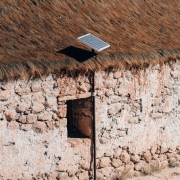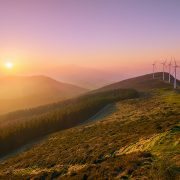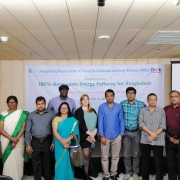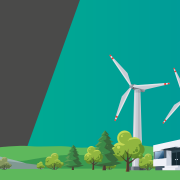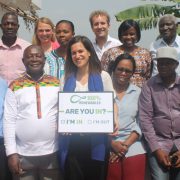Tag Archive for: Energy & just Development
What are Solar Home Systems?
Imagine you live in a house with no access to the energy grid. How to get access to basic functions? Solar Home Systems can be a solution.
What is just transition?
The term just transition is on everybody’s lips. But what does it actually mean?
Global Renewables Congress to be launched at UN Climate Conference
PR: Global Renewables Congress to be launched at UN Climate Conference
Hamburg/Katowice, 10 December 2018 – The 24th UN Climate Conference (COP24) is underway in Katowice, Poland (2-14 December). After countless unusual weather events have wreaked havoc all over the globe this year, this round of climate change negotiations comes at a critical time. Implementing far-reaching changes to our societies to cut carbon and phase-out fossil fuels has become inevitable. Against this backdrop, the Global Renewables Congress (GRC) will be launched on December 11 on the sidelines of COP24. The GRC is a new cross-country, cross-party platform for ongoing dialogue between and with legislators for the rapid and large-scale deployment of renewable energy solutions. Current and former legislators from national and regional parliaments can become members of the GRC. The GRC is chaired by Bärbel Höhn, former MP of the German Bundestag and acting Commissioner for Energy Reform in Africa for the Federal Ministry of Economic Cooperation and Development.
“Only a swift transition to renewable energies can halt climate crisis and save us from its devastating impacts”, states Bärbel Höhn. “We must deliver renewables at scale. In order to stand a chance of avoiding the catastrophic consequences of climate crisis, renewable energy solutions need to be deployed more widely and rapidly than ever before. The GRC has great potential to advance them on a global level.”
Co-Chairs are appointed representing each of the major regions of the world. The World Future Council provides the secretariat of the GRC.
“A series of recent reports, including the IPCC 1.5 Special Report, makes it clear that we are nowhere near on track to meet the goals of the Paris Agreement”, argues Rob van Riet, Director of the Climate Energy Programme at the World Future Council. “The good news is that a clean energy transition is technologically feasible, and that it can act as a catalyst for achieving the Agenda 2030; the bad news is that political will still falters and vested interests resist this transformation of our energy system. The GRC aims for the rapid and large-scale deployment of renewables and I am optimistic it will bring decision-makers together to create the synergies needed for this process.”
The GRC is made possible through the support of the German Federal Environmental Foundation (Deutsche Bundesstiftung Umwelt/DBU) and the Stiftung Mercator. Additional support for this project was made available by Mr. Amir Roughani, Ambassador for the World Future Council.
MORE INFORMATION
www.renewablescongress.org
Anna Skowron
Project Manager Climate & Energy, World Future Council
anna.skowron@worldfuturecouncil.org
MEDIA CONTACT
Miriam Petersen
Media & Communications Manager
World Future Council
miriam.petersen@worldfuturecouncil.org
+49 (0) 40 3070914-19
About the World Future Council
The World Future Council (WFC) works to pass on a healthy planet and fair societies to our children and grandchildren. To achieve this, we focus on identifying and spreading effective, future-just policy solutions and promote their implementation worldwide. Jakob von Uexkull, the Founder of the Alternative Nobel Prize, launched the World Future Council in 2007. We are an independent, non-profit organisation under German law and finance our activities from donations. For information visit www.worldfuturecouncil.org
Interview on the Energy Transition in Germany
„We need a citizen-oriented energy supply“
The energy transition can only succeed if energy supply is democratised. We talked to Uli Ahlke, head of the district office for climate protection and sustainability in Steinfurt (North Rhine-Westphalia, Germany), about success factors of community energy.
Citizens contribute significantly to the energy transition. Including farmers, individuals own about 42% of all renewable energy installations in Germany[2]. Unfortunately though, the German federal government does not support community energy sufficiently. At this point, local governments can make a decisive contribution to promoting community energy. The German District of Steinfurt, near the Dutch border, is setting an exemplary path. Its 24 municipalities with about 445,000 inhabitants aim to be energy self-sufficient through renewable energies by 2050 – with the greatest possible participation of the local population. Already today more than 60% of the electricity stems from renewables. We talked to Uli Ahlke, head of the district office for climate protection and sustainability, about strategies and possibilities for local authorities to support community energy, about dealing with national obstacles, and about the future of the energy transition.
Community Energy: Energy Transition
The International Renewable Energy Agency (IRENA) Coalition for Action describes community energy as “the economic and operational participation and/or ownership by citizens or members of a defined community in a renewable energy project” – regardless of size and scope of the project.[1] Community energy is any combination of at least two of the following elements: Local stakeholders own more than half or all shares of a renewable energy project; voting control rests with a community-based organisation; and the majority of social and economic benefits are decentralised locally.
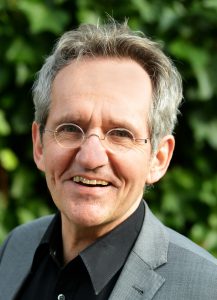
Engagement for community energy: Uli Ahlke is head of the district office for climate protection and sustainability in Steinfurt (North Rhine-Westphalia, Germany)
World Future Council: The district of Steinfurt aims to be energy self-sufficient through renewable energies by 2050. Supporting community energy is an integral part of your work. Why did you choose to support community energy to promote the expansion of renewables rather than focusing on large-scale investments?
Uli Ahlke: We have conducted several surveys in our region, and we know that the balance sheet energy self-sufficiency can only be accomplished once we operate in a regionally decentralised manner – and that it won’t work without the citizens. About 18 years ago, we experienced a very intensive expansion of wind energy with a lot of foreign investors in our region. At that time, we quickly reached acceptance limits.
We are convinced that we cannot achieve our ambitious goals without wind energy. That is why we asked ourselves what we need to do to maintain acceptance for a new expansion momentum. We needed to involve people in the planning process and to give the local community the opportunity to participate in local value creation. After all, the district of Steinfurt spends 1.5 billion euros a year on energy – for electricity, heat and mobility energy. Money we want to keep in the region.
How exactly can community energy be integrated into local climate action planning, and which participation mechanisms were particularly effective in Steinfurt?
What we do here is only possible because we have this team. We are 22 employees who take charge of the region’s sustainable development, of rural development, climate protection and education for sustainable development. Structurally, we consolidated the whole procedure last year and founded an association – the “energieland2050”. We communicate through traditional media, but are increasingly active in social media; we organise broad-scale participation proceedings; we place a strong focus on the regional advantages; and we have many amplifiers, especially on the part of the wind farmers.
As part of the wind energy expansion, we have set guidelines for all upcoming civic wind farms – in cooperation with the property owners, i.e. the farmers, with the farmers’ association, the municipal utilities and our 24 mayors. These guidelines not only guarantee the involvement of citizens, but also ensure that the first focal point for loans are local banks, and for energy marketing the municipal utilities. For the recruitment of financial resources through public participation we organised three events for one wind farm alone, attended by around 900 people. Two weeks later, we had 30 million euros, although we only needed 15.
In 2011, we set up a “Wind Energy Service Station”. There, we have a colleague, who deals with conflict management. She talks to the people and seeks solutions with them whenever there is a problem. We also launched a “Wind Energy Round Table”, where we regularly invite all stakeholders involved in wind energy to address conflicts openly and transparently.
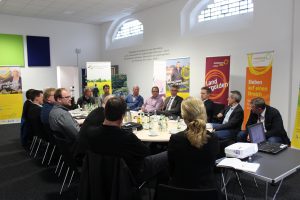
Round table discussions for solving conflicts
But wind energy is just one piece of the puzzle. Our goal is to initiate climate action in the region, involving more and more people. Many people trust us; that we practice what we preach, that we do things well, and that we act in accordance with the Agenda 21[3]. But that did not come out of the blue – it emerged over the years, during which people got to know each other, and learned to trust each other. I also believe that sustainability and regionalism are closely interlinked because we give up anonymity and work with people we know.
I agree with you. How do you deal with national legal and regulatory obstacles to citizen-owned renewable energy installations at the local level, such as the 2017 Renewable Energies Act (EEG) Amendment[4]?
I believe that the energy transition can only succeed if there is – in Hermann Scheer’s words – the “democratisation of energy supply”. The 2017 EEG Amendment, however, weakened the community energy movement. The reason for this weakening is presumably an energy policy that is geared towards corporations. But we need a policy that is citizen-oriented. The corporation-oriented policy actually prevents a successful energy transition. I am following Berlin’s energy policy with concern. If we do not change course very quickly, we will certainly miss the 2-degree target.
The approach we chose in Steinfurt is characterised by our energetic imperative “regional – decentralised – CO2-neutral”. This is supported and accompanied by the “energieland2050 network of entrepreneurs”. Only responsible companies from the region are involved in this network.
A study by the Leuphana University of Lüneburg has shown that the main obstacle to initiate community energy projects are the availability of equity capital and access to vacant space for renewable energy installations like wind turbines. How can local authorities help in these areas?
At the beginning, we conducted a study to identify our potentials for the wind energy expansion. We must not forget that our region is not particularly suitable for wind energy; we are not a coastal region and are partially suburbanised. On the basis of the potential study, we developed the guidelines for civic wind energy together with the farmers’ association, the mayors and many other stakeholders. This accelerated the expansion of wind energy. We implemented the wind energy expansion with regional stakeholders and did not rely on any external project planner or consultant. The expansion was also largely financed from the region – from its citizens, and its local banks. This is a relatively unique approach in Germany.
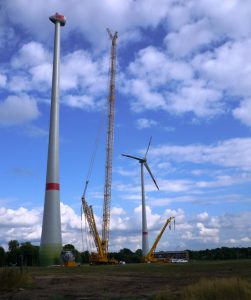
Construction of the bioenergy park Saerbeck
When we started to address wind energy with some actors in 2010 and even approached it strategically, people were very sceptical. And today I look back very relaxed and say: It worked!
I am glad to hear that. Let us now come to the last question. You have been working with passion for many years in this area. Which advice can you give to people in local governments not to lose patience and confidence in their work for renewables and citizen participation?
What you need is perseverance, patience and the faculty of abstraction. Human beings are often too impatient and cannot imagine the world changing but it is changing faster than ever. I think that in order to win people it is not enough to have good arguments, but it is important to draw a picture, a future scenario, of where you want to go and how positive the future can look like. At the end of my speeches, I often show a picture of the district of Steinfurt, which says: “District of Steinfurt – 24 health resorts”. If the energy transition succeeds, we will breathe clean air and it will be quieter. So if it succeeds, and I suppose that it does succeed at least partially, then life becomes more enjoyable and we get out of the air pollution dilemma which we are in now.
Interview conducted by Nele Kress.
References
[1] IRENA Coalition for Action (2018). Community Energy. Broadening the Ownership of Renewables. https://bit.ly/2MCevv9 (28.08.2018).
[2] Agentur für Erneuerbare Energien (2018). Bürgerenergie bleibt Schlüssel für erfolgreiche Energiewende. https://bit.ly/2nztV4q (28.08.2018).
[3] Agenda 21 is a comprehensive plan of action to be taken globally, nationally and locally by organisations of the United Nations system, governments, and major groups in every area in which human beings impact on the environment. It was adopted by 172 governments at the United Nations Conference on Environment and Development (UNCED) held in Rio de Janeiro in 1992.
[4] The Renewable Energies Act (EEG), which came into force for the first time in 2000, is the central control instrument for the expansion of renewable energies in the field of electricity in Germany. The fundamental changes of the last major amendment to the EEG in 2017 relate to compulsory direct marketing and a fundamental system change from the feed-in tariff model to the tendering procedure. This model has been criticized for failing to meet the climate protection goals of the Paris Agreement and for discriminating against community energy projects.
China Urban Development Review
Abstract
China is undergoing one of the fastest and largest urbanisation processes in the world. This process has two facets, one is the incremental expansion of urban populations and cities, while the other is that urban quality is increasingly gaining people’s attention.
With this paper we wish to call together observers to review the urban development process, and we want to be advisors and facilitators for urban development through collecting cases and igniting people’s passion for improving our cities. We live and work in cities, there is no reason to sit and do nothing when our cities deserve more care.
Clearing the Air in India with the fresh breeze of biomass technology
Every year India struggles with natural conditions of drifting dust from the desert Thar[1] which are aggravated by human impact[2] and lead to environmentally, socially and economically costly air pollution. With the enabling policy framework, a proven technology could be part of a feasible scheme tackling all anthropogenic drivers at once – and ideally lead to a reduction of air pollution by up to 90%.
Starting a few months ago, India’s North has made headlines when air pollution reached an air quality index (AQI) of 1,001[3] – exceeding safe levels by a multitude of ten. In the national Capital Region of Delhi alone 45 million people[4] have been affected, causing a spike in complaints of respiratory problems and an emergency state, declared by the Indian Medical Association.[5]
Even though the news around the topic subsided, the officially monitored AQI which are even higher in the proximity of roads[6] within major cities like Delhi, Mumbai, Chennai, Hyderabad and Kolkata, continue to range around hazardous levels[7]. Inhalation of this air is comparable to smoking several packs of cigarettes a day[8] [9] and serious respiratory effects in the general population can be expected while even putting susceptible groups at risk of premature death[10].

Figure 1: Haze over North India in late 2017. (Source: NASA, 2017)
The death toll of air pollution in India was the highest of all countries around the world with 2,5 million in 2015.[11] A global UNICEF study found recently, that over 90% of children are breathing polluted air not matching WHO guidelines and 17 million infants are exposed to levels six times the approved norms.[12] Furthermore, household air pollution was recently discovered to be insalubrious even before birth, reducing birth weight, pregnancy duration and doubling perinatal mortality[13]. This effect is owed to the burning of traditional fuels which exposes mostly women to pulmonary and vision hazards of indoor air pollution.[14]
A study conducted by the World Bank concluded: The negative health impact of outdoor air pollution alone costs India 3% of its GDP[15] which translates to an equivalent loss of roughly 35 billion Euros every year. Research found a direct impact of the atmospheric pollution on agriculture with wheat yields of 2010 being on average up to 36% lower than usual all over India due to reduced intensity of sunlight and toxic ozone reaching the plants.[16] Additionally, increased amounts of carbon dioxide in the atmosphere[17] contribute to the greenhouse effect leading to more extreme and destructive weather events.
Two main causes for a myriad of manmade emission sources
In agricultural areas such as Punjab, the breadbasket of India, which singlehandedly produces 20% of India’s wheat and 10% of its rice[18], smoke blankets rise seasonally for several weeks despite a governmental ban when leftover straw stubble from mechanical harvesting is burned openly in the fields to clean the soil for new seeding [19] (see fig. 2).

Large-scale crop burning in India in 2017. (Source: Propakistani, 2016)
Then, metropolitan areas are covered by the drifting haze of crop burning in addition to the smoke of millions of wood cook stoves in and outside of the urban areas as well as countless emitters of sulfates, nitrates and black carbon such as automobiles, coal-fired power plants, incinerators, smelters or brick kilns.[20]
A comparison of several studies of Delhi shows the difficulty of solving the problem due to the relatively equal share of the main human-made sources of urban air pollution: Open burning of garbage and other diffused emitters contribute on average about a quarter, domestic or biomass burning as well as dust ranges around 15% while both traffic and industry (including coal power plants) are responsible for approximately one third.[21] [22]
However, understanding the reasons of air pollution, the interconnectedness of land and city and the amplification of fog and aerosol hazes[23] permits a vision for a future of clear skies and fresh breath. The main detrimental causes showed to be unsolvable if tackled one by one which is demonstrated by governmental emergency measures falling short every year.
Multiplying the negative causes turns into a feasible opportunity
The usually unused agricultural leftover biomass like paddy straw suddenly becomes an additional source of income for farmers as it already begins to prove itself as a viable source for power generation in rural India, offering employment for thousands of people. The calorific value per kilogram of coal and paddy straw are comparable while it burns cleanly in boilers with an efficiency as high as 99%. Combustion technology is commercialized and alone in the state of Punjab 332.5 MW of agro-waste based power projects are planned.[24]
These power plants can sell their power due to the “New & Renewable Sources of Energy Policy” and generate income under a Clean Development Mechanism while suppling millions of kWh to the grid for years. [25] Even individual households value the significant financial benefit of a carbon credit scheme which earns them up to 500 Rupees per month in a pilot project and convinces them to maintain the use of improved cook stoves.[26]
There are numerous reasons aside from health benefits for extending the understanding of sustainable cooking beyond improved cook stoves[27]. A new one is provided by a recent study, that noted villagers truly wish for cooking like in the cities – preferably with LPG which is out of reach for many due to its higher costs compared to wood.[28] The so-called producer gas of low-cost straw-based power plants is an ideal replacement of a cleanly burning fuel, reducing indoor air pollution significantly in poor or disconnected rural and urban households alike.
Moreover, the processing of biomass and organic waste opens the opportunity of bio-oil production which can be handled exactly like a petroleum-based product to power suited diesel generators and fuel traffic in the cities.[29] This not only reduces transport emissions greatly but adds value to the commonly high share of organic waste (~30%) in Indian cities[30], attracting the informal sector in waste collection and reducing open garbage burning.
If now the government would take a leap forward by providing legislative support for this scheme in a holistic framework and additionally phase out coal power plants, manmade air pollution could ideally be reduced by roughly up to 90% through counteracting the aforementioned emission sources. In addition to environmental and social health improvements, the positive economic impact would be substantial: An IRENA study estimated a total benefit of 59 to 224 billion USD in savings following a restructuring of the power sector.[31] India’s INDC target of 40% renewable energy in 2030 is a promising step into the right direction.[32]
– written by Lisa Harseim –
[1] https://earthobservatory.nasa.gov/IOTD/view.php?id=84731
[2] http://www.urbanemissions.info/wp-content/uploads/images/PMSA-Delhi-UEinfo-2013-Study.png
[3] https://visibleearth.nasa.gov/view.php?id=91240
[4] https://www.nytimes.com/2017/11/07/world/asia/delhi-pollution-gas-chamber.html?mc=adintl&mcid=facebook&mccr=edit&ad-keywords=GlobalTruth
[5] https://www.visibleearth.nasa.gov/view.php?id=86982
[6] http://www.dw.com/en/study-offers-new-insight-into-new-delhis-air-pollution-woes/a-18105674
[7] http://clonewdelhi.com/custom/AQI/missionindiaaqi.php#
[8] https://www.nytimes.com/2017/11/07/world/asia/delhi-pollution-gas-chamber.html?mc=adintl&mcid=facebook&mccr=edit&ad-keywords=GlobalTruth
[9] http://www.theweek.in/columns/shashi-tharoor/dont-hold-your-breath.html
[10] https://www.visibleearth.nasa.gov/view.php?id=86982
[11] https://www.nytimes.com/2017/11/07/world/asia/delhi-pollution-gas-chamber.html?mc=adintl&mcid=facebook&mccr=edit&ad-keywords=GlobalTruth
[12] http://cleancookstoves.org/about/news/01-04-2018-new-study-shows-clean-cooking-can-lead-to-increased-birth-weight-in-newborns.html
[13] https://www.sciencedirect.com/science/article/pii/S0160412017312448
[14] https://www.solarquarter.com/index.php/resources/83-industry-reports/6245-remap-renewable-energy-prospects-for-india
[15] http://www.worldbank.org/en/news/press-release/2013/07/17/india-green-growth-necessary-and-affordable-for-india-says-new-world-bank-report
[16] https://www.ncbi.nlm.nih.gov/pmc/articles/PMC4246269/
[17] https://link.springer.com/chapter/10.1007/978-81-322-2014-5_4#page-1
[18] https://www.visibleearth.nasa.gov/view.php?id=86982
[19] http://www.dailymail.co.uk/indiahome/indianews/article-5055737/Crop-burning-ban-goes-flames-Punjab-Haryana.html
[20] https://earthobservatory.nasa.gov/IOTD/view.php?id=84731
[21] http://www.dw.com/en/study-offers-new-insight-into-new-delhis-air-pollution-woes/a-18105674
[22] www.urbanemissions.info
[23] https://earthobservatory.nasa.gov/IOTD/view.php?id=84731
[24] https://link.springer.com/chapter/10.1007/978-81-322-2014-5_4#page-1
[25] https://link.springer.com/chapter/10.1007/978-81-322-2014-5_4#page-1
[26]https://www.povertyactionlab.org/sites/default/files/India_%20Cooking%20up%20a%20recipe%20for%20clean%20air%20%281%29.pdf
[27] https://www.worldfuturecouncil.org/file/2016/10/WFC_BeyondFire_web-version.pdf
[28] https://www.povertyactionlab.org/evaluation/cooking-stoves-indoor-air-pollution-and-respiratory-health-india
[29] https://link.springer.com/chapter/10.1007/978-81-322-2014-5_4#page-1
[30] http://www.academia.edu/6034600/State_of_municipal_solid_waste_management_in_Delhi_the_capital_of_India
[31] http://www.irena.org/publications/2017/May/Renewable-Energy-Prospects-for-India
[32] http://www.ren21.net/gsr-2017/pages/tables/tables/#table-R15
100% renewable energy and poverty reduction in Tanzania
The World Future Council, Bread for the World and CAN-Tanzania hosted a workshop in February Dar es Salaam, Tanzania to kick-off an 18-months project, aiming at exploring the feasibility of 100% RE targets and its implications for Tanzania’s Sustainable Low Carbon Development and Poverty Reduction Goals.
